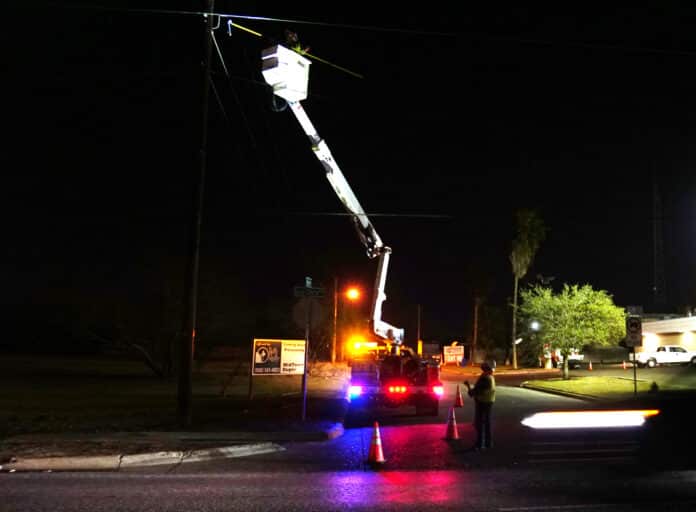Rolling blackouts are one thing. Sitting in an unheated house or apartment for days in a row while the temperature outside hovers at or below freezing is another.
Hundreds of Brownsville residents found themselves in that predicament during last week’s winter assault on Texas and the Rio Grande Valley. Several of the state’s power plants began going offline around 1 a.m. on Feb. 15 as the Arctic invasion caused equipment and instrumentation to freeze up and electrical generation to cease at the same time demand for power was soaring statewide.
To keep the state’s power grid from collapsing entirely, the Electric Reliability Council of Texas ordered mandatory rolling blackouts in cities across Texas, including Brownsville. These rotating outages were supposed to last an hour or two at most before power was restored and then another segment of town made to sit in the dark.
In many cases it didn’t work, explained Brownsville Public Utilities Board General Manager John Bruciak at a Feb. 18 joint press conference with the city of Brownsville. It wasn’t because the city-owned utility lacked sufficient generating capacity, he said. BPUB, with 50,000 customers, has a power plant in Brownsville, owns part of another one in Edinburg and also part of a wind farm around Hebbronville, he said.
“We had more than enough power supply for Brownsville,” Bruciak said. “There was no shortage of power. We were restricted by ERCOT how much of that power supply we could use because of the shortfall in the state.”
The reason for the shortfall was that the state’s power plants have not been winterized, despite a report from the North American Electric Reliability Council following a winter 2011 that caused major outages in Texas. NAERC warned that a similar catastrophe could occur again without winterization, and indeed it came to pass last week, though worse than in 2011.
Wind turbines froze up as well, also because they have not been winterized, although wind supplies only 20 percent of the state’s power generation compared to more than 47 percent from natural gas power plants.
Bruciak said the unusual combination of events last week — rolling outages during an ice storm — contributed to so many Brownsville and Valley residents being without power for so long.
“A lot of the problems we had when we started rotating circuits and feeders is when we tried to activate some of those, there were equipment failures on those feeders and circuits,” he said.
BPUB would bring a feeder online and crews would move onto the next one, only to have to come back to the first one because of a blown fuse or other problem, Bruciak said. That was caused by the huge demand once a feeder was turned on, hence BPUB’s repeated calls to the public to turn everything off while the power was out.
“Especially in cold weather situations … all your appliances are on, your heaters are on, space heaters,” Bruciak said. “When they all come on, transformers aren’t made for that kind of a load instantaneously. And that was a big problem. Once that happens you cause damage to the substation and you’ve got to go back in there.
“Brownsville County Club was an example. We could not get that subdivision energized because of the load in there. It would trip the breaker at the substation and transformers. So we had to go in there an isolate that subdivision in segments, and bring that back at a slower pace, so those people were out a long time.”
The same scenario was playing out in other parts of the city, Bruciak said. As far as what can be done locally to prevent a repeat, BPUB is determined to look at ways to improve the infrastructure where needed, he said.
“We certainly learned a lot in this event, both on what our shortfalls are in cold weather,” Bruciak said. “And also our communication to the public to let them know what’s happening. I think we were spending more time trying to fix the problem … than we were letting the people know how we were trying to fix that problem. We’ve got to improve on that going forward.”
Speaking at the press conference, Brownsville Mayor Trey Mendez praised crews for BPUB and other area providers who had been working around the clock to restore power to residents. As for local infrastructure, he said, “we do have some local issues that are going to be addressed.”
“I think the biggest lesson so far is we’ve got a lot of work to do, not just city-wide but statewide (with) our electrical and power infrastructure,” Mendez said. “There’s a been a lot of finger pointing throughout the state as to who’s to blame. I think that will surface over the next couple weeks.”
He said he plans to encourage further investment in Brownsville’s power infrastructure. If it’s revealed that there are problems with the local grid that were known but not addressed, “that’s certainly something that there should be accountability for,” Mendez said.
“But if you just couldn’t reasonably predict, you can’t really necessarily blame too much,” he said. “If they knew and it was an actual deficiency that existed, or something that could have been improved or upgraded, then yeah, that could be a problem.”
PREVIOUS COVERAGE




